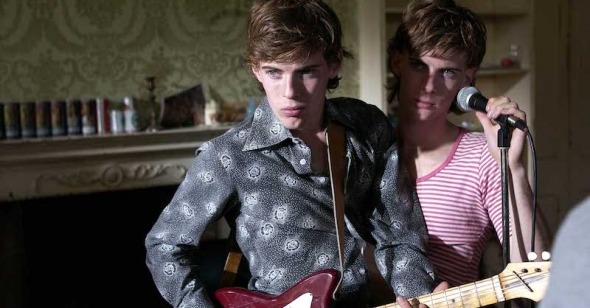Thalidomide Babes
by Leah Churner
Brothers of the Head
Dir. Keith Fulton and Louis Pepe, U.S., IFC Films
Tod Browning’s Freaks endures because it allows us to satisfy our morbid curiosity from the comfort of our own self-righteousness. If exploitation films are martyrs to our guiltily bigoted psyches, they are a necessity in a culture of political correctness. Furthermore, in an age where laborious rituals of self-transformation are so imperative, from joining the gym to hooking our bodies up to tissue vacuums and silicone pumps, it's unsurprising that we have a certain preoccupation with the easy auto-mutilation of severe birth defects. Brothers of the Head appeals to this sort of morbidity while graciously pretending to critique it, and meanwhile contains the singularly democratic balance of visual pleasure and pain one expects from a good horror film. Beyond the easy task of throwing a boner to our darker impulses, the movie stands out as a ravenous niche-filler, cleverest in its invention of anti-Olsens. The formula: take one part archetypal bad boy, multiply him by two, then raise the badness quotient exponentially by uniting the results through a veiny protrusion of frontal flesh. Add guitars, roll cameras. It’s a genre-sundae, too, a gooey confection of rise-and-fall rock epic, monster show, bizarre love triangle, docudrama, and fetish film. In my book, the excesses and furtive pleasures in Brothers of the Head are precisely the sort of lax ideals that summertime cinema stands for.
Co-director Keith Fulton recently told indieWIRE that the greatest obstacle for Brothers of the Head was marketing it, which is a real knee-slapper. After attending the premiere, it's hard to imagine the commercial potential of their sack of gimmicks wasn't blaring like a foghorn since the infancy of the project. The marketing departments at IFC, Fuse TV, and Spin magazine are hemorrhaging with hokey promotional shenanigans—among other materials, IFC distributed fake Kinko's-style fanzines (a cutely conscious throwback to the "pre-blog days"), with the fake band's real Myspace.com URL printed on the back (as of press time, 869 fabulous friends). The ads, slapped all over coveted surfaces on 14th Street, in the margins of Gawker, and at the Bedford Avenue stop, are in the poorest taste of all, conspicuous down-to-the font replicas of the iconic Trainspotting posters. All of this has more to say about the shitty world of marketing than the film itself. If you can sit through the dizzying battery of logos before the opening credits (three distributors, five production companies) you may be surprised to find that the hype-engines have somehow fallen in step with real talent and originality.
As you may have heard, the details of Todd and Barry's lives are relayed in a mock-documentary format, through present day interviews with their sister, their lawyer, their manager, band members, a D.A. Pennebaker–type documentarian with “original footage” from 1975, as well as a few wild cards: Ken Russell (playing himself as a filmmaker who made an unfinished biopic about the boys) and, briefly, Brian Aldiss, who (in real life) wrote the 1977 novel Brothers of the Head. (As a side note, when Louis Pepe and Keith Fulton approached Aldiss about adapting the story, he liked their pitch so much he gave them the option for free.) Because it takes at least 90 minutes to become inured to the repulsive sexiness of the Siamese twins, Brothers merits two viewings. The second time, I found myself chuckling rather than squirming, as it was easier to appreciate the film’s wittier moments.
Pepe and Fulton keep their cards to their chests until about three-quarters of the way through the film, when we get a whiff of a secret that was the core of Aldiss’s book: the boys have a third “twin,” a fetal tumor in Barry's cranium, who is “waking up.” I can see the rationale for presenting the pivotal plot device as a twist ending—the moment of revelation pays off in goosebumps—but the elation is short-lived. After we find out about the possible existence of the third twin, who may just be their imaginary friend Nelson, conjured from their childhood memory through heavy drug use, the film loses steam. The imp inside the freaks, certainly the story's best idea, is cast aside for some reason. Ultimately it is not the tumor but Todd's girlfriend, Laura, who is blamed for the boys’ demise. The Yoko allegory worked in Spinal Tap because it was a joke. Here, however, we have no puffy purple moon sweaters or mispronunciations of “Dolby” to sustain any laughs. Laura is a dumpy, wilting flower child, whose annoying presence is the only really awful thing about the film.
That Pepe and Fulton were able to find two identical, blindingly handsome teen Brits who possess a wealth of musical skill and screen presence, and are cool with doing sex scenes together, is flabbergasting, and it may very well be that I am defending this movie because I am smitten with the twins.
But it’s more than their looks; it’s the knowledge that the film is in some way a portrait of the actors’ real-life relationship. Throughout, they articulate a physical tenderness superior to any that we non-twins will ever experience, inspiring longing and envy while exposing the crudeness of our sexual curiosity about them. Despite all the glittery antics of this outwardly casual smorgasbord, and the embarrassing ploys of its wayward marketers, I found myself affected by the film days later, haunted with the suspicion that the ideal natural order may be a binary one.
